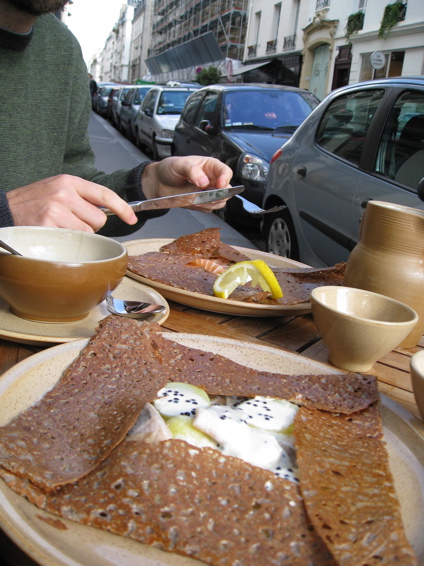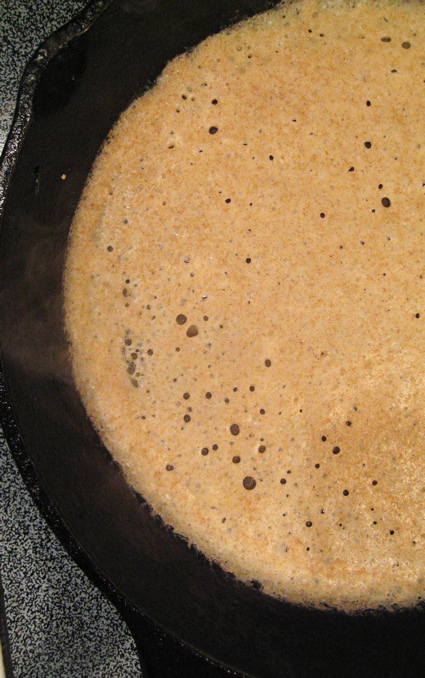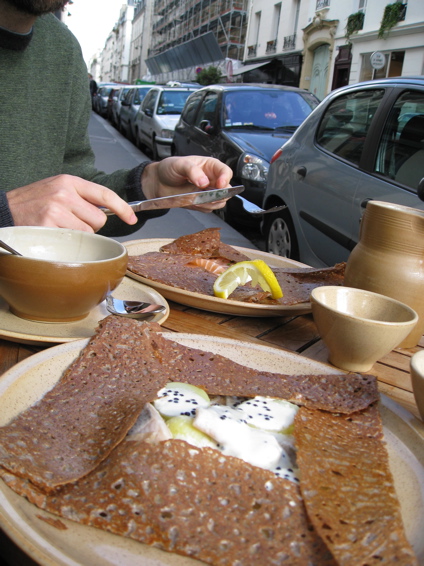 Just add Paris: buckwheat crepes in their glory.April McGregerMy love for buckwheat first blossomed in the Soba-ya shops of Japan. Years later, that love was rekindled on the sidewalks of Paris eating Galletes de Sarrasin, or Breton-style savory buckwheat crepes, washed down with hard apple cider in stoneware cups. I found the deep, pleasantly bitter, and earthy flavor of buckwheat satisfying and nourishing. The soba noodles were delicate and wholesome; the crepes were lacy yet substantial.
Just add Paris: buckwheat crepes in their glory.April McGregerMy love for buckwheat first blossomed in the Soba-ya shops of Japan. Years later, that love was rekindled on the sidewalks of Paris eating Galletes de Sarrasin, or Breton-style savory buckwheat crepes, washed down with hard apple cider in stoneware cups. I found the deep, pleasantly bitter, and earthy flavor of buckwheat satisfying and nourishing. The soba noodles were delicate and wholesome; the crepes were lacy yet substantial.
Buckwheat is a curious and misunderstood food. It’s not a grain, but is treated like one. It’s actually a shrub, related to rhubarb, and its seeds or kernels are what get ground into flour. Buckwheat has been a traditional food around the world, particularly in regions with short growing seasons and poor soil. Eastern Europeans eat a porridge of toasted buckwheat kernels, or groats, known as kasha. In the mountainous region of Lombardy, Italy, a buckwheat pasta, known as pizzoccheri, is a traditional winter fare. They toss it with butter, cabbage, cheese, garlic, and sage.
Buckwheat has a lot going for it: It offers dynamic flavor, contains no gluten, has as much as four times the fiber of whole wheat flour, and is a complete protein. I figured it was time buckwheat got its culinary due stateside.
As often happens when I begin to research “new” ingredients like buckwheat or chestnuts, I often find that the food is not new at all, but a lost or obscure tradition. It turns out that buckwheat was one of the earliest crops introduced to North American by Europeans. Buckwheat griddlecakes and cane syrup or sorghum molasses were considered a most fortifying breakfast for early American pioneers, homesteaders, and farmers.
 Buckwheat in the field.According to Glenn Roberts, founder of Anson Mills, “grain” consumption in the United States was once much more diverse. In order to farm successfully without modern chemical fertilizers, crop rotation and cover cropping was necessary. Buckwheat was a key player in good, natural farming practices. It was planted to break up heavy clay soils, to control erosion, and as a valuable green manure. In addition, the nectar from buckwheat flowers is much loved by bees and makes a delicious dark colored honey, and buckwheat flour was a valuable food in its own right, particularly during the cold months.
Buckwheat in the field.According to Glenn Roberts, founder of Anson Mills, “grain” consumption in the United States was once much more diverse. In order to farm successfully without modern chemical fertilizers, crop rotation and cover cropping was necessary. Buckwheat was a key player in good, natural farming practices. It was planted to break up heavy clay soils, to control erosion, and as a valuable green manure. In addition, the nectar from buckwheat flowers is much loved by bees and makes a delicious dark colored honey, and buckwheat flour was a valuable food in its own right, particularly during the cold months.
Buckwheat cultivation declined sharply in the 20th century due the use of synthetic nitrogen fertilizer. Interestingly–unlike crops like corn and wheat–buckwheat plants yield less in soils treated with synthetic nitrogen. Buckwheat’s history reveals a direct connection between the rise of modern agriculture–with its chemical-intensive monocrops–and the decline of traditional foodways and the emergence of a homogenized Western diet based on refined grains, meat, and sweets. We must then realize the connection between reviving heirloom grains, fixing the broken food system of the United States, and returning to the tradition of natural farming.
 Crepe batter, sizzling in the pan.Photo: April McGregerBuckwheat Crepes, or Galettes de Sarrasin
Crepe batter, sizzling in the pan.Photo: April McGregerBuckwheat Crepes, or Galettes de Sarrasin
Sweet crepes are very popular and widespread in the United States, but the savory buckwheat crepe remains obscure. By far my preferred crepe, it is basic and unpretentious–but also totally elegant. Crepes require a bit of practice to master, but once you do, you’ll get lots of dinner party mileage out of the simple technique. Fillings are endlessly adaptable and are any easy way to turn leftovers into satisfying, nourishing comfort food. Traditionally, buckwheat crepes are made with just water, but the milk makes them slightly easier to deal with. If you are new to crepe making, I recommend sticking to easy low-prep fillings until you get your timing down.
Crepe dough:
3/4 cup plus 2 Tablespoons buckwheat flour
1/4 cup all-purpose flour
2 eggs
2 cups milk
2 cups water
1 Tablespoon melted butter
Filling ideas:
-Roasted beets with horseradish cream and dill
-Ham & cheese
-Sharp cheese & chutney
-Caramelized onions with sauted apples & crispy bacon
-Cabbage and potatoes with spicy mustard butter
-Garlicky greens with bacon & a fried farm egg
-Sauted mushrooms with thyme & smoked farmer’s cheese
-Smoked salmon with crème fraiche & chives
-Herb roasted root vegetables and tomato chutney
-Herbed goat cheese
-Pork rillettes or pate’
-Chicken or scallops in white wine cream sauce with flat leaf parsley
Makes 12 medium crepes
Prepare the dough:
In a food processor or blender, break the eggs. Add the flours and mix until well blended. Add as much of the milk and mix thoroughly. Then mix in the water. If your blender of food processor will not hold all of the liquid, finish whisking in a large bowl.
If you don’t have a food processor, you can mix your batter with a whisk in a large bowl. First measure out your flours and make a well in the center. Break the eggs in the well, and whisk them in. Then slowly pour in the milk in, whisking constantly, and then the water. Strain the batter through a fine meshed sieve and refrigerate it overnight. Don’t shortcut this or your crepes will be difficult to work with.
Cooking the crepes:
You should have your filling prepared and warm before you begin making your crepes. Take your prepared batter out of the fridge. Whisk as some of the flour will have settled at the bottom of the bowl.
If you’re making more than a couple of crepes, preheat the oven to 250°F to hold your crepes warm while you make the others.
Heat up a large non-stick skillet (I use a well-seasoned cast iron skillet) over medium-high heat. When it is very hot, put in a sliver of salted butter and then wipe it out with a crumpled paper towel so that the butter is spread thinly and evenly on the surface of the skillet.
Pour a ladleful (about a ¼ cup of batter for a 10-inch skillet) of batter in the skillet, and swirl the skillet around so that the dough spreads out in a nice even circle. Small gaps in the dough are okay. Let cook on medium-high heat for a few minutes, peeking underneath with a spatula from time to time to check on the cooking. Flip the crepe when it’s nicely golden underneath. I find it easiest to loosen the edge of the crepe from the pan with a spatula, then use my fingers to pick up the crepe and flip it over.
Put the filling of your choice in the center of the crepe while the second side cooks. When the second side is golden brown, fold in two of edges. The traditional way is to fold the four sides in and make a square crepe, but professionally made crepes are much bigger in diameter and make that technique easier.
Put the crepes on a cookie sheet and into the oven to keep warm while you make the others. These are best served with hard apple cider.
Apple Butter Buckwheat Cake
I had a buckwheat revelation this year, when I first encountered it in cake form. It was rustic, wholesome, and surprising, and I knew it was the beginning of an exploration for me. This is one of my favorite recipes that I have come up with. It’s the perfect breakfast or afternoon cake with a pot of black tea on a chilly fall day. My favorite buckwheat is by far from Anson Mills. My second choice is Bob’s Red Mill. For the gluten intolerant, substitute the wheat flour with Bob’s Red Mill gluten free baking mix.
Makes 1 loaf pan
1 cup buckwheat flour
1 1/4 cup + 1 Tablespoon unbleached all purpose flour
1 Tablespoons baking powder
½ teaspoon kosher salt
3 large eggs (plus one extra for brushing tops later)
1 cup sugar
14 Tablespoons melted butter
2 Tablespoons bourbon
1 teaspoon vanilla extract
1/4 cup apple juice
Grated zest of 1 orange
Homemade or store-bought apple butter (here’s my apple butter recipe from the fall)
In a large bowl whisk eggs, sugar, butter, bourbon, vanilla extract, apple juice, and orange zest. In a separate bowl, whisk together flour, buckwheat, baking powder, and salt. Sift dries into wet ingredients and fold in. Refrigerate the batter for at least 3 hours, preferably overnight, to firm up.
Spoon batter into greased pans lined with parchment to 2/3’s full. Top with a few spoonfuls of apple butter. Top with the rest of the batter. Using a knife, swirl the apple butter into the cake batter slightly. Do not over mix — you do not want it blended. You want the apple butter to show through in places.
Brush the top of the cake with egg wash and sprinkle with turbinado sugar.
Bake at 400 degrees about an hour or until a toothpick or sharp knife comes out clean. If the cake is browning too much you can place a piece of foil over them. Let cool in the pan on a rack for about 30 minutes. Then run a knife around the edges to loosen any compote that is stuck to the sides and invert. If you wish, you can top the cake with powdered sugar or just serve simply with tea for a nourishing snack.



